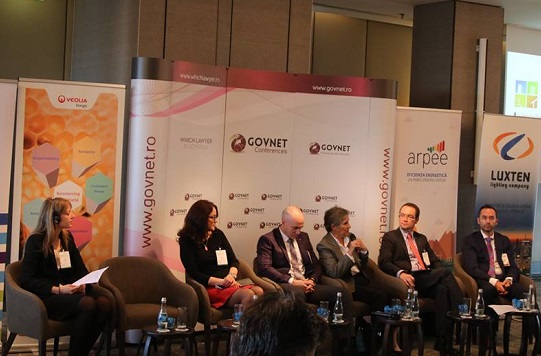Energy efficiency projects developed in Romania, favoured sectors and available financing solutions

The Romanian Energy Efficiency Forum, the most important annual event dedicated to the development of sustainable energy programs, reached its fourth edition on Thursday, October 12. At the discussion table came key people in this sector, from Government representatives, specialists from project developers, large profile companies, and banks that can fund this sector.
Organized by the Romanian Association for the Promotion of Energy Efficiency (ARPEE), together with GOVNET Conferences, the debate highlighted both legal bottlenecks and the present opportunities in energy sector, concrete project financing solutions and examples of good practice at the local level.
In the opening of the Forum, Razvan Grecu, President of ARPEE, made a brief radiography of the current situation, highlighting Romania's achievements, as well as the failures of Romania in the field of energy efficiency. According to him, primary energy consumption has declined sharply in Romania over the last 30 years, including after 2000, when economic growth was resumed.
"Industry has cut consumption, while the residential sector remains somewhat constant. There have been ideas that this low consumption is caused by the deindustrialisation of the economy. It's not a complete picture, we should not neglect companies' efforts to invest in energy efficiency. The statistical reports show that between 2000 and 2015 Romania had technical energy efficiency of 15 million equivalent oil," the ARPEE representative pointed out.
He also reminded that in the electricity production area there has been a change in the mix in recent years, from gas and coal power stations to major nuclear and renewable energy projects and the transport area is on an upward slope due to the influence of EU legislation on Diesel. Also, in the residential segment there have been some losses in recent years, but not significant.
In the perspective of the next 10 years, Razvan Grecu spoke of uncertainty: "The evolution of consumption will be dictated by the evolution of the economic, public policies. In terms of investment financing, it is a big problem in the energy area, anda more acute problem in the area of energy efficiency. There are many fiscal, financial obstacles to project development."
The ARPEE President also said that there are initiatives, but we are far from what is happening in the EU, we have proposals that have not been put to the end, we have a problem of profitability of investments in energy efficiency and domestic consumers do not yet afford significant investments in energy efficiency. He also brought into discussion the change of the legislative framework, so that public authorities can play a more important role in programs for energy efficiency in hospitals and schools.
Alessia Endellini, Policy Officer at EFIEES, the European Federation of Intelligent Energy Efficiency Services in Brussels, spoke about the current changes to the European Commission's post-2020 energy efficiency agenda, referring in particular to the Energy Performance of Buildings Directive, which introduced "decarbonisation" of national building stocks and the promotion of alternative solutions to classical renovations in the construction sector, in the long run.
Dumitra Mereuta, Energy Councelorfor Energy Problems, Ministry of Environment, said that theoretically, we have achieved our European target for 2020, but in practice, things are not exactly true, recalling that in the period 2000-2014, CO2 emissions linked to road transport doubled. Also, the Government representative spoke about the high potential in the residential area, given that there are European funds in this respect, about the 68 municipalities that have adhered to the Mayors Convention and who have begun to make important steps in the development on the energy efficiency area.
As for the institutional communication, Dumitra Mereuta said that the Ministry of Energy and ANRE should be supported by the Ministry of Environment and especially by the Ministry of Finance, "because they depend on their approval mainly". In her view, the priorities of the Ministry of Environment by 2020 should be recruiting properly trained people, accessing EU funds and re-establishing the Climate Change Directorate.
Aurelia Simion, Head of Service, General Directorate for Regional Development and Infrastructure, MDRAPFE, presented the amendments to the EU Directive on Energy Efficiency of Buildings, referring to the legislative package approved in November 2016. "Emphasis is placed on increasing the number of buildings with almost zero energy consumption, all the buildings to be built must have the infrastructure for charging electric car batteries. An Intelligent Building Indicator is also introduced."
"Regarding the financing of the measures packages to increase energy efficiency in buildings, there is a national plan to increase the performance of apartment blocks. There is also a financing plan through the Regional Operational Program - Axis 3 - Residential Buildings (538 million Euros) and Public Buildings and Public Lighting (409 million euros)," said Aurelia Simion.
Concerning the good practices in the industry, as well as at the public level, several case studies were presented:
Gheorghe Dobra, General Manager of Vimetco ALRO, spoke about the company's plans to implement a 190 million dollars long-term investment program (2017-2021) to increase energy efficiency and lower the company's consumption. In the first half of this year, ALRO has completed over 16 million dollars in primary and processed aluminum. In the primary aluminum sector, the company earned a 1.5 million dollar annual savings, and in the processed aluminum, a five-fold reduction in specific electricity consumption.
Carmen Badici, engineer, member of “Light Smart System” project team Luxten Lighting Company SA, presented the project for the rehabilitation and modernization of the public lighting system in Constanta Metropolitan Area, finalized in 2016 - 5 large districts (Compositors, Palazu Mare, Baba Novac, Constanta South, Peninsula) and 4 boulevards (Mamaia, Aurel Vlaicu, Tomis, Ferdinand) – with LED, sodium and metal halide technologies.
Bogdan Anton, Project Manager - Energy Transition Energy Transition,presented a project for energy efficiency in Bacau - 475 km of electrical networks related to the illumination of nearly 200 km of streets, as well as the illumination of pedestrian alleys, parks, bridges, tunnels, passages. Among the proposed measures are the replacement of existing lighting poles with new metallic poles, the underground switching of the power supply, the modernization of the control/command system and the introduction of a tele-management system.
Doina Vornicu, CEO, CEZ Romania, reminded of the largest wind farm in Europe, developed by CEZ in Dobrogea with 1.1 billion euros, highlighting the issue of public-private partnership and the lack of conviction from the final consumers: "Institutions, consumers are not convinced of utility, no one will invest if we do not convince them. Public-private partnership does not work, we will not take big steps in that direction as long as it does not work. We closed the entities and everything we managed to open up as new consumption points are on newer and upgraded technologies, but also with a smaller production capacity," Doina Vornicu explained.
Corneliu Rotaru, expert in energy efficiency, insisted on the idea of implementing a performance monitoring system for energy consumption that will contribute, through efficient data processing, to increasing the energy management capacity in companies. Thus, funding for energy efficiency projects can be attracted very easily. Also, as European funds for industry have declined sharply, companies should not target very large projects, and it is desirable to limit themselves to sums up to 400,000 euros, financially sustainable.
And because funding solutions are a crucial part of developing energy efficiency projects, the forum debated alternatives to European funds, available and easier to access.
Daniela Ionescu, Urban Infrastructure Specialist, European Bank for Reconstruction and Development (EBRD)said that EBRD has a total of 100 million euros for Romania to invest in energy efficiency on residential buildings. In addition, through the EBRD, Banca Transilvania can lend to individuals in Romania 40 million euros, in the form of green mortgages, for energy efficient housing.
In turn, Oana Mogoi, coordinator of BCR's energy infrastructure team, explained the barriers to the development of energy efficiency projects: the legal framework is vague, the payment guarantees are not well developed, the procurement process is still too ambiguous and time consuming for local ESCOs, the Energy Performance Contract (EPC) is not regulated in public procurement contracts, the project preparation is difficult due to insufficient and unclear data (especially reference consumption) and lack of coherence between the procedures of different institutions (ANRE, ANRSC, ANAF, etc.).
"We should take the example of mature markets, we should also implement best practices. This is where everything goes - from a clear, coherent and stable legislative system," explained Oana Mogoi.
"In the case of bank financing, given the fairly long term of energy performance contracts, this can be seen in the financing costs and cash-flows of ESCO companies. What would we look at as a financier? First of all, at ESCO, how much does it have and what financial situation it has, if it is able to implement the project, to operate it for the next 10-15 years. Same thing for the recipient. If the beneficiary disappears, we certainly have zero savings. In connection with the energy efficiencycontract, it must provide a fair allocation of risks among all parties, provide guarantees and it can not be ended by either party unilaterally," the BCR official said.
Mihai Tudorancea, Managing Partner TUD Financial Solutions, proposed another approach to the financing of energy efficiency projects: The City Hall can be seen as an ESCO - investing in the rehabilitation of residential buildings, it has the opportunity for 10 years to recover 20% of the amount from owners through rehabilitation fee. Practically, the City Hall would be the bearer of the investments, and the savings made would have a significant impact on consumption.
The partners of the conference were ALRO, ANRE, CEZ Group, Engie, Ethan Allen, Horizon 2020 - GuarantEE Building Energy Services in Europe, Linde Gaz Romania, Luxten Lighting Company SA, Mitsubishi, OMV Petrom, Schneider Electric, Telekom, TUD Financial Solutions, Veolia Romania.




